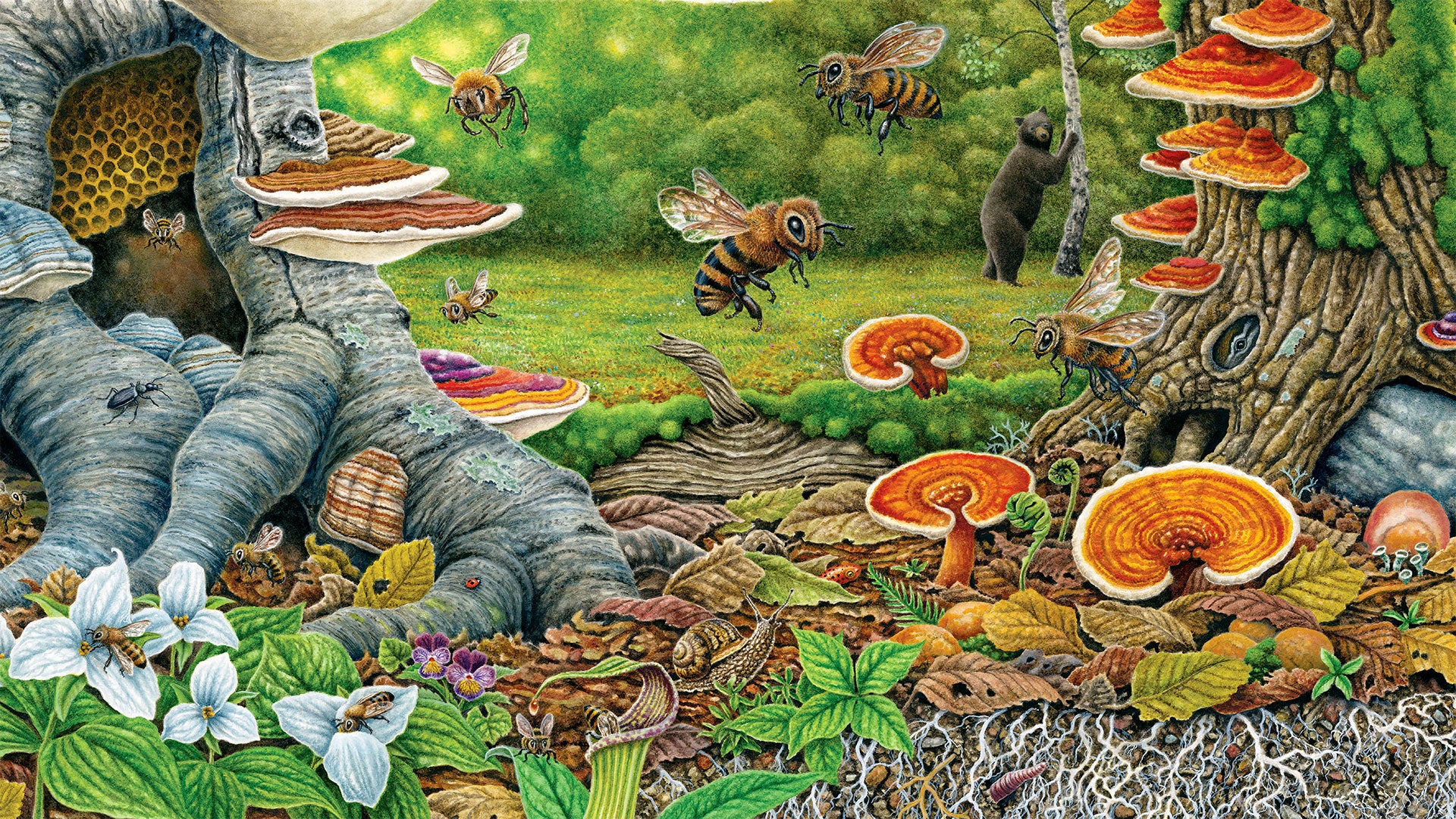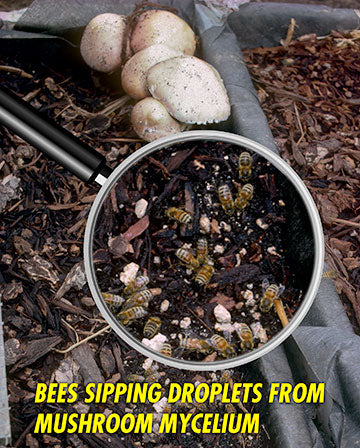
Bee Friendly Research Update 3
Greetings fellow Fungiphiles and the Bee-Mushroomed !
This Earth Day we’re excited to share the latest developments in our Bee Friendly™ Research Initiative, originally unveiled by Paul Stamets during the 2014 Bioneers Annual Conference. For those unfamiliar with the story, our “Bee Friendly” campaign is an initiative created to support the research and development of fungal strategies to improve bee health and offset the use of toxic pesticides.
The devastating phenomenon known as Colony Collapse Disorder was first officially recognized in 2006. Honey bee hives continue to die off at rates of 30–40% each winter. According to the USDA, the winter of 2015–2016 was the worst on record, when up to 44% of hives died (no data is yet available for winter 2016–2017.) This should be concerning to all, as approximately one out of every three bites of food human beings eat comes from a source that depends upon pollination by bees*.
In 2014, Paul Stamets teamed up with the Dr. Steve Sheppard, entomologist and head of the Washington State University APIS Molecular Systematics Laboratory to investigate the potential benefits of exposing honey bees to certain species of fungi. In the initial set of experiments, fungal extracts were fed to bees to determine their effects. The preliminary results suggest that extracts of certain polypore mushrooms can increase worker bee longevity and reduce viral burden.
Researchers suspect the nutritional support from fungal extracts is playing a significant role in improving bee health. The sugar syrup bees are typically fed is high in calories but non-nutritious, lacking phytochemicals and micronutrients. Fortifying this syrup with fungal extracts provides a wide assortment of B vitamins and other myconutrients critical for bee health.
A second set of experiments investigated delivery systems and mechanisms of action of Metarhizium spp. (a species of entomopathogenic fungi) to control populations of Varroa destructor mites, considered to be a major contributor to Colony Collapse. These fungi parasitize Varroa mites, greatly reducing them as a threat. (While bees can be susceptible to Metarhizium, because they are meticulous groomers, they easily wipe away the Metarhizium spores, thus avoiding infection.) Unfortunately, current mite controls often focus on chemical treatment that also harms bees and weakens their immune systems significantly. Metarhizium can be effective against mites and remain mostly harmless to adult bees or brood. Although factors such as temperature of the hive can affect the growth of the fungus and limit efficacy, experiments are underway to overcome this obstacle.

Female Varroa destructor mite on the head of a honey bee nymph. By Gilles San Martin from Namur, Belgium (CC BY-SA 2.0), via Wikimedia Commons.
Over the past winter, Bee Friendly research expanded to field testing of our Host Defense fungal extracts on more than 500 hives here in Washington State. Following this, extracts of Reishi (Ganoderma lucidum) and Amadou (Fomes fomentarius)were sent to San Joaquin valley in California for distribution during the almond pollination season. San Joaquin Valley is the largest worldwide producer of almonds where every almond tree blooms for approximately 3 weeks each February. During this time, 532 hives were given fungal extracts, making this the largest field study on honey bees in history! Now that the almond bloom is over, researchers from the United States Department of Agriculture are analyzing the results. More information should be available as soon as this summer.
We are often asked whether we have a product available specifically for supporting bee health. Our products for bees are still in development, but we are working with expert entomologists on field testing and optimization of our formulas. We are currently conducting full-scale field tests measuring survival of treated and untreated colonies under diverse locations and producer conditions. The research-to-date is very exciting, and new products tuned to bees will be launched in 2018 at the latest.
Many ask “What can I can do to help?” According to the WSU APIS bee team, the best thing you can do now is to grow more flowering plants to encourage and support your local bee hives. Another important step is to encourage natural decomposition in your environment whenever possible. Fallen logs and old stumps become habitats for many organisms, including bees, and the subsequent bloom of mushrooms and other organisms not only act as a source of nutrition for the bees, but help to enhance the biome as a whole. As Paul suggests, we should all start using the mantra “Let it Rot!”

In addition to flowering plants, the presence of live mushrooms might be an important part of the puzzle. Paul Stamets first became aware of this relationship in the summer of 1984, when he observed beds of Stropharia rugoso-annulata (commonly called the King Stropharia, Garden Giant or the Wine Cap) on his property attracting bee activity. Paul saw continuous convoys of bees from the hives to the beds, from dawn to dusk. Upon close examination, he saw bees sipping on the exudates secreted by the mycelium. Much later, the issue of Colony Collapse sparked this memory, and now we may have a significant new defense we can use to help bees.
If you'd like to start cultivating this mushroom species, you can do so in two ways. You can start with an Indoor Mushroom Patch, then transfer the mushroom mycelium to an outdoor bed once it has finished producing indoors, or you can proceed directly to an outside mushroom bed with the Outdoor Mushroom Patch. Both come with a complete instruction booklet for growing (it should be noted that the instructions do not mention bees). Another option is to grow mushrooms on logs and stumps using our Mushroom Plug Spawn. Our research has shown that extracts of the Reishi mushroom (Ganoderma lucidum s.l.) have a significant beneficial impact on bees. Our customer support team is also available by phone (800-780-9126) or email (info@fungi.com) to answer any questions you may have while cultivating.

Paul Stamets, Washington Senator Judith Warnick and WSU Provost & Executive Vice President Dr. Dan Bernardo pose with a $50,000 donation for bee research and the WSU APIS Bee Laboratory
Our ongoing Bee Friendly initiative encompasses research, development, and outreach and is intended to draw attention to the many ways that fungi may be able to help reverse the devastating declines in the global bee population. The research-to-date has been made possible by the generous support of individuals, companies, and private foundations. In 2016, the Bee Friendly Research Initiative raised and donated $50,000 for a new Honey Bee and Pollinator Research Center at WSU. We are looking to donate another $50,000 in 2017. Paul also recently teamed up with innovative director, cinematographer and time-lapse photographer Louie Schwartzberg and delivered an amazing presentation, “Mushrooms and the Mycology of Consciousness,” at the Moore Theater in Seattle. Over 1,200 people attended, raising an additional $16,000 for bee research. Continued financial support of the WSU Honey Bee Research Laboratory makes this novel research possible. If you would like to contribute, donations to WSU can be made securely online here.
Happy Earth Day from everyone at Fungi Perfecti!

The California Academy of Science recently posted a short video to their bioGraphic Web site, produced by filmmaker Louie Schwartzberg, about Paul's work with WSU. You can view it here.
*Natural Resources Defense Council
